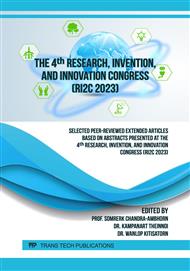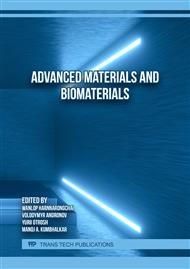[1]
N. Chananpanich, R. Yeetsorn, S. Chuayprakong, Feasibility study on protective film products Innovation and Technology Assistance Program (ITAP) Technical Report Phase 1 (2017).
Google Scholar
[2]
MICE Intelligence Center, Tire and Rubber Industry of Thailand (2019)
Google Scholar
[3]
S. Chuayprakong, J. Chuchat, T. Poruksa, M. Soccio, Feasibility of Using Natural Rubber (NR) Latex Foam as a Soft Robotic Finger: Role of Foaming Agent in Morphology and Dynamic Properties of NR Latex Foam, Applied Science and Engineering Progress, 14 (2021) 80-88.
DOI: 10.14416/j.asep.2020.12.004
Google Scholar
[4]
S. Chuayprakong, Control of Film Formation and Defects of Thin Film Prepared from Sulphur Vulcanised NR Latex by Straight Dipping Process, Master Thesis, Mahidol University, Bangkok, Thailand, 2005.
Google Scholar
[5]
P.J. Flory, J. Rehner, Statistical Mechanics of Cross-linked Polymer Networks. Part I: Rubber-like Elasticity. J. Chem. Phys., 11 (1943) 512-526.
DOI: 10.1063/1.1723791
Google Scholar
[6]
N. Tangboriboon, S. Rortchanakarn, K. Petcharoen, A. Sirivat, Effects of Foaming Agents and Calcium Carbonate on Thermo-Mechanical Properties of Natural Rubber Foams Polimeri, 35 (2014) 10-17.
Google Scholar
[7]
M. Oliveira, L.C.M. Cirilo, M. Nele, J.C. Pinto, Synthesis of spherical core-shell poly(vinyl acetate)/poly(vinyl alcohol) particles for use in vascular embolization: Study of morphological and molecular modifications during shell formation. Polymer Engineering and Science 55 (2015) 2237-2244.
DOI: 10.1002/pen.24109
Google Scholar
[8]
O.Squillace, R.Fong, O. Shepherd, J. Hind, J. Tellam, N.J. Steinke, R.L. Thompson, Influence of PVAc/PVA Hydrolysis on Additive Surface Activity. Polymers 2020, 12, 205.
DOI: 10.3390/polym12010205
Google Scholar
[9]
S.B. Yang, S.H. Yoo, J.S. Lee, J.W. Kim, J.H. Yeum, Surface Properties of a Novel Poly(vinyl alcohol) Film Prepared by Heterogeneous Saponification of Poly(vinyl acetate) Film, Polymers (Basel). 9 (2017) 493.
DOI: 10.3390/polym9100493
Google Scholar
[10]
V. Jyothi, A. Sunny, T. Sabu, Thermal degradation of natural rubber/styrene butadiene rubber latex blends by thermogravimetric method, Polym-Plast Technol Eng, 39 (2010) 415-435.
DOI: 10.1081/ppt-100100038
Google Scholar
[11]
J. Wu, N. Wang, L. Wang, H. Dong, Y. Zhao and L. Jiang, Soft Matter, 8 (2012) 5996.
Google Scholar
[12]
G. Acik, C.E. Cansoy, M. Kamaci, Effect of flow rate on wetting and optical properties of electrospun poly(vinyl acetate) micro-fibers. Colloid Polym Sci 297 (2019) 77–83.
DOI: 10.1007/s00396-018-4443-3
Google Scholar



